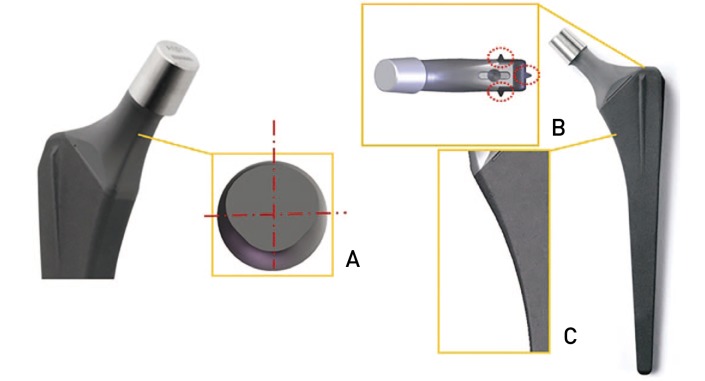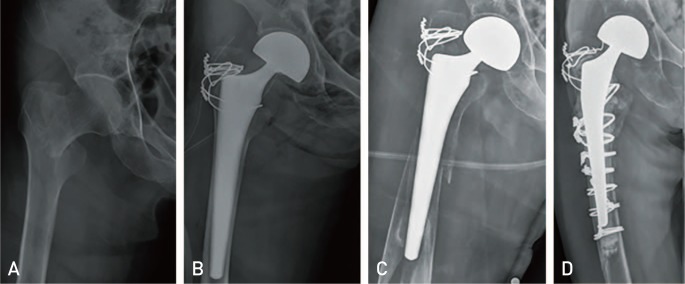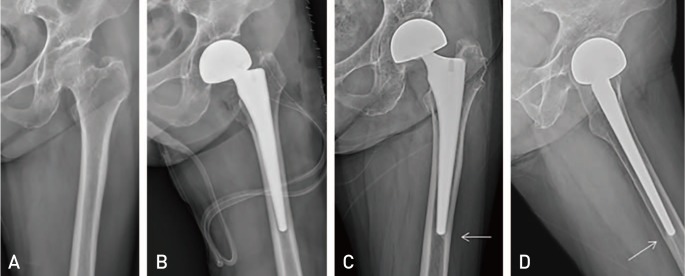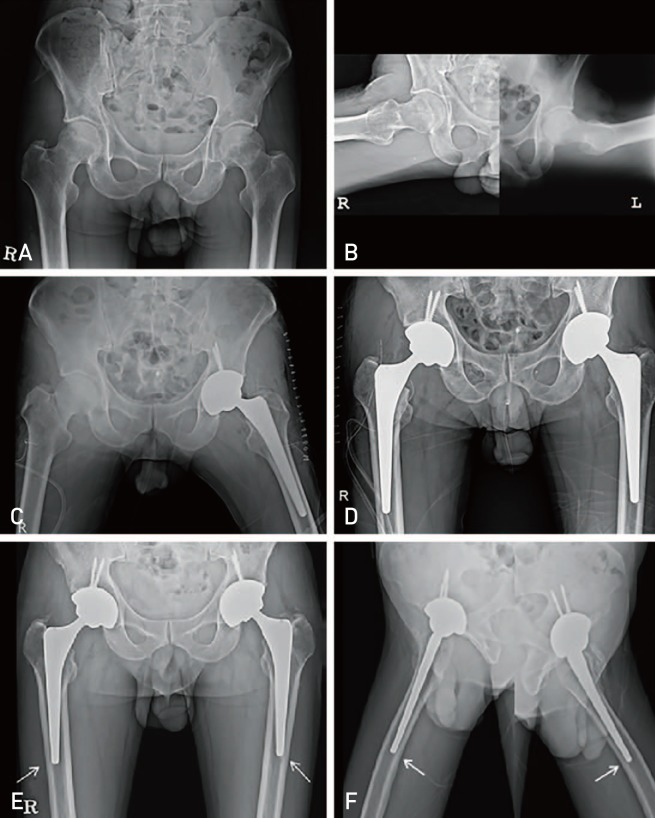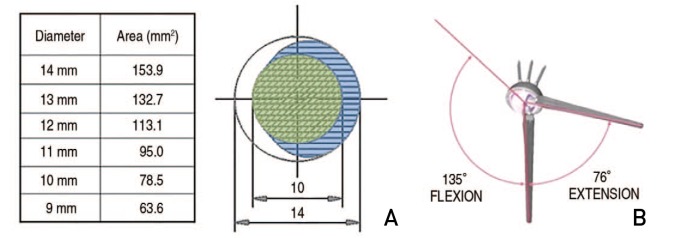Hip Pelvis.
2018 Dec;30(4):210-218. 10.5371/hp.2018.30.4.210.
Hip Arthroplasty Using the Bencox® Hip System: An Evaluation of a Consecutive Series of One Thousand Cases
- Affiliations
-
- 1Department of Orthopaedic Surgery, CHA Bundang Medical Center, CHA University, Seongnam, Korea. drjmlee@naver.com
- KMID: 2427924
- DOI: http://doi.org/10.5371/hp.2018.30.4.210
Abstract
- PURPOSE
This is a report on the outcomes associated with a consecutive series of 1,000 cementless hip arthroplasties utilizing the Bencox® hip stem-the first Korean-developed hip prosthesis.
MATERIALS AND METHODS
A consecutive series of 1,000 hip arthroplasties using the Bencox® hip stem were analyzed, starting from its initial release (September 2006) until June 2014. Patients in this consecutive series underwent surgery for fractures (n=552), arthritis (n=155), avascular necrosis (n=209), and revisions (n=84). Of these 1,000 cases, patients with a minimum follow-up of at least 1 year (n=616) were retrospectively analyzed for radiographic and clinical outcomes (i.e., Harris hip score). The stability of the prosthesis was evaluated by examining subsidence.
RESULTS
During the follow-up period (mean follow-up period of 54.8 months), there were 2 cases requiring revision of the femoral stem-both were caused by periprosthetic fractures and neither involved stem loosening. The mean Harris hip score during follow-up was 95.5. Bone ongrowth occurred in 95% of patients; no cases of subsidence or aseptic loosening of the stem were detected, and no cases of postoperative complications such as ceramic breakage were observed.
CONCLUSION
Clinical and radiographic evaluations of hip arthroplasty using the Bencox® hip stem revealed excellent outcomes with an average of 54.8 month follow-up in a consecutive series of 1,000 cases.
MeSH Terms
Figure
Cited by 1 articles
-
Clinical and Radiological Outcomes of Rectangular Tapered Cementless Stem According to Proximal Femoral Geometry in Elderly Asian Patients
Joon Soon Kang, Sang Hyun Ko, Yeop Na, Yung Hun Youn
Hip Pelvis. 2019;31(4):224-231. doi: 10.5371/hp.2019.31.4.224.
Reference
-
1. Learmonth ID, Young C, Rorabeck C. The operation of the century: total hip replacement. Lancet. 2007; 370:1508–1519. PMID: 17964352.
Article2. Banaszkiewicz PA. Radiological demarcation of cemented sockets in total hip replacement. In : Banaszkiewicz PA, Kader D, editors. Classic Papers in Orthopaedics. London: Springer;2014. p. 39–41.3. Rothman RH, Cohn JC. Cemented versus cementless total hip arthroplasty. A critical review. Clin Orthop Relat Res. 1990; (254):153–169.4. Malik A, Maheshwari A, Dorr LD. Impingement with total hip replacement. J Bone Joint Surg Am. 2007; 89:1832–1842. PMID: 17671025.
Article5. Kim S, Lee JM, Kim WH, Han JK, Lee JY, Choi BI. Focal peliosis hepatis as a mimicker of hepatic tumors: radiological-pathological correlation. J Comput Assist Tomogr. 2007; 31:79–85. PMID: 17259837.6. Kim JT, Yoo JJ. Implant design in cementless hip arthroplasty. Hip Pelvis. 2016; 28:65–75. PMID: 27536647.
Article7. Lim Y, Chang YJ, Kwon SY, Kim YS. A simple method using a PACS to minimize leg length discrepancy in primary THA: a method to minimize leg length discrepancy. J Arthroplasty. 2013; 28:1791–1795. PMID: 23540533.8. Bourne RB, Rorabeck CH. Soft tissue balancing: the hip. J Arthroplasty. 2002; 17(4 Suppl 1):17–22. PMID: 12068397.
Article9. Masonis JL, Bourne RB. Surgical approach, abductor function, and total hip arthroplasty dislocation. Clin Orthop Relat Res. 2002; (405):46–53. PMID: 12461355.
Article10. Lee JM, Cho Y, Kim J, Kim DW. Wiring techniques for the fixation of trochanteric fragments during bipolar hemiarthroplasty for femoral intertrochanteric fracture: Clinical study and technical note. Hip Pelvis. 2017; 29:44–53. PMID: 28316962.
Article11. Banaszkiewicz PA. Ectopic ossification following total hip replacement: incidence and a method of classification. In : Banaszkiewicz PA, Kader D, editors. Classic Papers in Orthopaedics. London: Springer;2014. p. 105–107.12. Chan KC, Gill GS. Cemented hemiarthroplasties for elderly patients with intertrochanteric fractures. Clin Orthop Relat Res. 2000; (371):206–215.
Article13. von Roth P, Abdel MP, Harmsen WS, Berry DJ. Cemented bipolar hemiarthroplasty provides definitive treatment for femoral neck fractures at 20 years and beyond. Clin Orthop Relat Res. 2015; 473:3595–3599. PMID: 26186915.
Article14. Hong CC, Nashi N, Makandura MC, Krishna L. Cemented hemiarthroplasty in traumatic displaced femoral neck fractures and deep vein thrombosis: is there really a link? Singapore Med J. 2016; 57:69–72. PMID: 26892829.
Article15. Stauffer RN. Ten-year follow-up study of total hip replacement. J Bone Joint Surg Am. 1982; 64:983–990. PMID: 7118986.
Article16. Sutherland CJ, Wilde AH, Borden LS, Marks KE. A ten-year follow-up of one hundred consecutive Müller curved-stem total hip-replacement arthroplasties. J Bone Joint Surg Am. 1982; 64:970–982. PMID: 7118985.
Article17. Bourne RB, Rorabeck CH, Ghazal ME, Lee MH. Pain in the thigh following total hip replacement with a porous-coated anatomic prosthesis for osteoarthrosis. A five-year follow-up study. J Bone Joint Surg Am. 1994; 76:1464–1470. PMID: 7929493.
Article18. Lavernia C, D'Apuzzo M, Hernandez V, Lee D. Thigh pain in primary total hip arthroplasty: the effects of elastic moduli. J Arthroplasty. 2004; 19(7 Suppl 2):10–16. PMID: 15457412.19. Lee JM, Jeon JB. Result of a minimum five-year follow-up of hip arthroplasty using the Bencox® hip stem. J Korean Orthop Assoc. 2014; 49:126–132.
Article20. Cruz-Pardos A, García-Rey E, García-Cimbrelo E. Total hip arthroplasty with use of the cementless Zweymüller Alloclassic System: A concise follow-up, at a minimum of 25 years, of a previous report. J Bone Joint Surg Am. 2017; 99:1927–1931. PMID: 29135666.21. Lee JM, Park YS. Long-term follow-up results after hip arthroplasty using a Cementless Spotorno (CLS) femoral stem. J Korean Orthop Assoc. 2008; 43:710–717.
Article22. Müller LA, Wenger N, Schramm M, Hohmann D, Forst R, Carl HD. Seventeen-year survival of the cementless CLS Spotorno stem. Arch Orthop Trauma Surg. 2010; 130:269–275. PMID: 19760225.
Article23. Haentjens P, Casteleyn PP, De Boeck H, Handelberg F, Opdecam P. Treatment of unstable intertrochanteric and subtrochanteric fractures in elderly patients. Primary bipolar arthroplasty compared with internal fixation. J Bone Joint Surg Am. 1989; 71:1214–1225. PMID: 2777850.
Article24. Barrack RL, Butler RA. Current status of trochanteric reattachment in complex total hip arthroplasty. Clin Orthop Relat Res. 2005; 441:237–242. PMID: 16331009.
Article
- Full Text Links
- Actions
-
Cited
- CITED
-
- Close
- Share
- Similar articles
-
- Analysis on Radiologic Assessment Following Uncemented Total Hip Arthroplasty
- Early experience with Dall-Miles cable grip system at femur fracture after hip arthroplasty: 3 case report
- The History of Total Hip Arthroplasty
- Modified Posterior Approach to Total Hip Arthroplasty
- Posterior Approach to Total Hip Joint Replacement Arthroplasty

